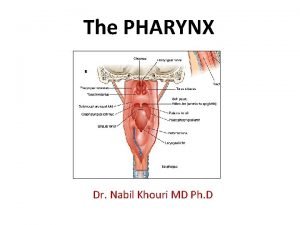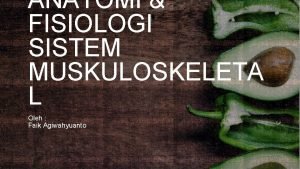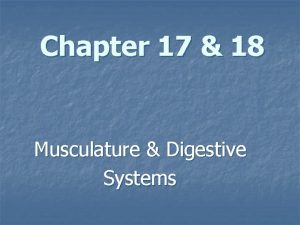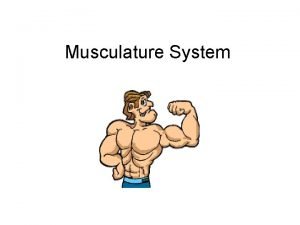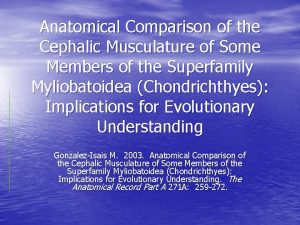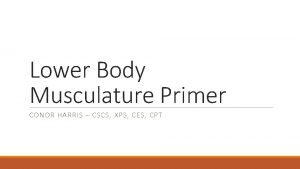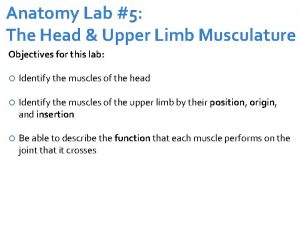Chapter 17 Musculature System The Musculature System The










- Slides: 10

Chapter 17 Musculature System

The Musculature System

The Musculature System n Includes 3 types of Muscle: n n Function of the Muscles: n n Striated, Smooth & Cardiac Provide means of Movement Keeps blood pumping Moves food thru Digestive System Skeletal Muscle usually in Antagonistic Pairs n n Flexor (bicep) Extensor (tricep)

n n n n n Skeletal Striated Voluntary Organ Smooth Involuntary Heart Cardiac Involuntary The Musculature System 3 Types of Muscle Tissue Skeletal, Smooth and Cardiac

How Muscles Work n n n Muscles can only contract & get shorter They cannot push things, they only pull. They are attached to two different bones and cause them to bend at the joint n n n Origin They work in Antagonistic Pairs n n Insertion n Origin – place the muscle attaches or begins (proximal) Insertion – place on the other side of joint muscle attaches (distal side) Flexors – cause the joint to bend – bicep Extensor – causes the joint to extend ( straighten out) - tricep Muscles are attached to bones w/ tendons

Smooth & Cardiac Muscle n n Smooth Muscle – usually are not voluntarily controlled. Found in the walls of hollow organs of the digestive tract & blood vessels. n They assist in the movement of food thru the digestive system (peristalsis) and movement of blood thru the circulatory system. Cardiac Muscle – found only in the heart. Similar to both Striated & Smooth Muscle tissue. Involuntarily controlled by brain.

Skeletal Muscle Structure n n Skeletal muscles are made up of bundles of muscle fibers which in turn are made of myofibrals (multi-nucleated muscle cells). Each myofibral is made of n n n thin filaments called Actin and thick filaments called Myosin. Muscle Bundle Fibers Myofibrils Filaments Actin & Myosin Each fiber is divided into functional units called sarcomeres tendon Muscle Bundle Fiber Sarcomere Myofibril Filaments

Skeletal Muscle Sarcomere n n n Sarcomere is divided into various zones. Each Sarcomere is separated by Z discs Light colored bands are I bands Dark colored bands are A bands Middle of the dark A band is H zone Middle of H zone is the M line Muscle contraction begins after a nerve stimulates the muscle fiber. n Actin Myosin

Skeletal Muscle Contraction n. Muscle contraction begins after a nerve stimulates the muscle fiber. n Impulse causes Actin filaments to slide over (like a ratchet) the Myosin filaments. n This shortens the length of the sarcomere. n Once contracted, the H zone closes up. n. This shortening isn’t much until you add up the thousands of sarcomeres in each muscle bundle. Actin Myosin

Need-to-Know Skeletal Muscles Know these muscles: Masseter, Trapezius, Deltoid, Pectoralis, Latissimus dorsi, intercostals, Rectus abdominis, External obliques, Biceps brachii, Triceps, Gluteus, Rectus femoris, Biceps femoris, gastronemius
